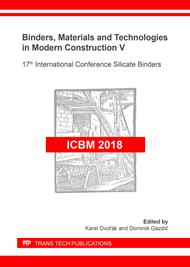[1]
M.D. Barbero-Barrera, L. Maldonado-Ramos, K. Van Balen, A. Garcia-Santos, F.J. Neila-Gonzalez, Lime render layers: an overview of their properties, Journal of Cultural Heritage 15 (2014) 326-330.
DOI: 10.1016/j.culher.2013.07.004
Google Scholar
[2]
A. Maropoulou, K. Polikreti, V. Ruf, G. Deodatis, San Francisco Monastery, Quito, Equador: characterisation of building materials, damage assessment and conservation considerations, Journal of Cultural Heritage 4 (2003) 101-108.
DOI: 10.1016/s1296-2074(03)00021-9
Google Scholar
[3]
R.P.J. Van Hees, L. Binda, I. Papayianni, E. Toubakari, Characterisation and damage analysis of old mortars, Materials and Structures 37 (2004) 644-648.
DOI: 10.1007/bf02483293
Google Scholar
[4]
C. Nunes, Z. Slížková, Freezing and thawing resistance of aerial lime mortar with metakaolin and a traditional water-repellent admixture, Construction and Building Materials 114 (2016) 896-905.
DOI: 10.1016/j.conbuildmat.2016.04.029
Google Scholar
[5]
T.G. Nijland, R.P.J. Van Hees, The volcanic foundation of Dutch architecture: Use of Rhenish tuff and trass in the Netherlands in the past two millennia, Heron 61 (2016) 69-98.
Google Scholar
[6]
P. Maravelaki-Kalaitzaki, A. Bakolas, I. Karatasios, V. Kilikoglu, Hydraulic lime mortars for the restoration of historic masonry in Crete, Cement and Concrete Research 35 (2005) 1577-1586.
DOI: 10.1016/j.cemconres.2004.09.001
Google Scholar
[7]
M. Tenconi, I. Karatasios, F. Balawi, V. Kilikoglou, Technological and microstructural characterization of mortars and plasters from the Roman site of Qasr Azraq, in Jordan, Journal of Cultural Heritage 33 (2018) 100-116.
DOI: 10.1016/j.culher.2018.03.005
Google Scholar
[8]
I. Papayianni, M. Stefanidou, Strength-porosity relationships in lime-pozzolan mortar, Construction and Building Materials 20 (2006) 700-705.
DOI: 10.1016/j.conbuildmat.2005.02.012
Google Scholar
[9]
M.A.O. Mydin, Preliminary studies on the development of lime-based mortar with added egg white, International Journal of Technology 5 (2017) 800-810.
DOI: 10.14716/ijtech.v8i5.442
Google Scholar
[10]
S. Fang, K. Zhang, H. Zhang, B. Zhang, A study of traditional blood lime mortar for restoration of ancient buildings, Cement and Concrete Research 75 (2015) 223-241.
DOI: 10.1016/j.cemconres.2015.06.006
Google Scholar
[11]
R. Ravi, T. Selvaraj, S.K. Sekar, Characteriasation of hydraulic lime mortar containing Opuntia ficus-indica as a bio-admixture for restoration applications, International Journal of Architectural Heritage 10 (2015) 714-725.
DOI: 10.1080/15583058.2015.1109735
Google Scholar
[12]
M.P. Seabra, H. Paiva, J.A. Labrincha, V.M. Ferreira, Admixtures effect on fresh state properties of aerial lime based mortars, Construction and Building Materials 23 (2009) 1147-1153.
DOI: 10.1016/j.conbuildmat.2008.06.008
Google Scholar
[13]
C. Nunes, Z. Slížková, Hydrophobic lime based mortars with linseed oil: Characterisation and durability assessment, Cement and Concrete Research 61-62 (2014) 28-39.
DOI: 10.1016/j.cemconres.2014.03.011
Google Scholar
[14]
EN 1015-3: Methods of test for mortar for masonry. Determination of consistence of fresh mortar (by flow table), (1999).
DOI: 10.3403/01541440
Google Scholar
[15]
EN 1015-7: Methods of test for mortar for masonry. Determination of air content of fresh mortar, (1999).
DOI: 10.3403/01541437
Google Scholar


